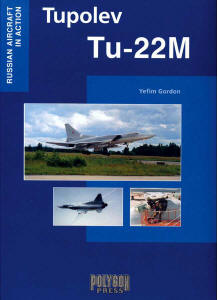|
Polygon Press |
|
Tupolev Tu-22M Russian Aircraft in Action |
|
by Yefim Gordon |
|
Reviewed By Charles Landrum, #26328 |
|
|
|
80 pages with over 200 color and B&W Photos in a hardbound edition MSRP $17.95 USD Review copy provided by Specialty Press 1-800-895-4585 The Tu-22 Backfire bomber was a nemesis of the US Navy during the later years of the cold war. Much effort went into defensive measures to counter its potent anti-ship punch; the KH-22 (NATO designation AS-4 “Kitchen”) was a powerful missile with a slippery profile. This threat resulted in the US Navy developing the sophisticated AEGIS weapon system. The Cold War is over, but the plane soldiers on as a tactical support platform in the air forces of Russian and Ukraine. Yefim Gordon, a prolific author with expertise on the aircraft of the former Soviet Union, provides a concise profile of this important aircraft. Unlike many of his titles released by other publishers, this book minimizes the text and focuses on photos; there are just three pages of text devoted to the development of the airframe. There are no chapters, just 70 pages of captioned photographs, most in color. In the final pages Gordon provides two pages of drawings of the final variant the Tu-22M3 and a page with a color profile of the Tu-22M2 and the Tu-22M3. The photos in the book provide good coverage of the variants of the aircraft. There are no new photos in this book, many are pretty standard and are available in other publications and even the internet. But what the book does provide are good views of the airframe in a single affordable hardbound volume. I do think the reproduction techniques and the lower weight paper used however detracts from an otherwise well-published book. The coverage starts with the prototype and quickly moves into the Tu-22M1 and M2. It was the M2 that caused such a stir in the West. My favorite photographs in the book are of the Tu-22M2 variant. Pages 16 and 17 show overhead views of the aircraft with the wings swept back and swept forward. This is not a sleek plane, and these overhead shots prove it, but overall it is a sinister-looking aircraft. The other notable image in these photographs is the clear view provided of the octagonal block ramp construction found at some former Soviet airfields. Since these earlier types are retired, the majority of the photographs focus on the Tu-22M3. Here the reader is rewarded with pictures of the KH-22 missile, the cabin, the engines, walk around shots and some nice shots of multiple aircraft in a massive concrete revetment – the sense of scale is overwhelming. The notable image in this collection is on page 37 and it is that of the nose taken from above with the gull wing doors to the cabin raised. It is notable because it clearly shows the maintenance panels to access the huge NATO designated “Down Beat” surface search and targeting radar. Overall I find this series of books a welcome addition to the growing reference body of information on the aircraft of the Soviet Union, Russia and the other successor states. It provides the armchair enthusiast and/or modeler an affordable reference on an important aircraft type. If you are like me and are more interested in the photographs as a modeling reference than the text, this book is for you. Recommended. |
|
Information, images, and all
other items placed electronically on this site |
